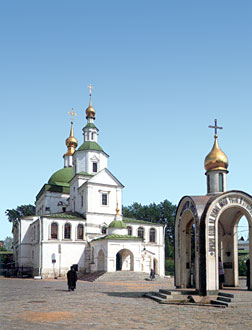 |
 Since 1983, the Danilov Monastery has been the official residence of the Russian Patriarch and the headquarters of the Russian Orthodox Church. It also holds claim to being the oldest monastery in Moscow, founded in 1282, although its checkered history and current importance give it a quite modern air.
Since 1983, the Danilov Monastery has been the official residence of the Russian Patriarch and the headquarters of the Russian Orthodox Church. It also holds claim to being the oldest monastery in Moscow, founded in 1282, although its checkered history and current importance give it a quite modern air.
The monastery takes its name from its founder, Prince Daniil Aleksandrovich, the youngest son of the great Novogorod ruler Aleksander Nevsky, who was the first prince of the then tiny principality of Moscow from 1276 to 1303. He was canonized in the 17th Century. His son, Ivan I, moved the monastery, its icons and its monks, to the Kremlin in 1330, and it wasn't until the reign of Ivan IV (the Terrible) that the Danilov Monastery became active again, mostly as a defensive structure.
The oldest building in the monastery today is the Cathedral of the Holy Fathers, which dates from 1565 and holds the remains of St. Daniil, and icons of him and of Our Lady of Vladimir painted around the time of the church's construction. The Cathedral has a complex structure, divided into several parts, including two chapels and a refectory. The exterior is painted white, with green roofs and gold cupolas. The main church in the monastery, however, is the 1838 Trinity Cathedral, an imposing neoclassical building by Osip Bove, the chief architect of Moscow's reconstruction after the Napoleonic Wars.
The monastery has several times in its history been at the centre of fighting. In 1591, the armies of the Crimean Tartar Khan were defeated beneath its walls. Twenty years later, the monastery was set on fire by the second False Dimitriy, and the walls and many of the buildings had to be entirely rebuilt. The French invaders of 1812 took St. Daniil's silver tabernacle, and desecrated the church interiors. The greatest damage, however, was done after the Revolution.
The Bolshevik government began to close the monastery's churches when it came to power. However, the monks continued their work until 1930, when a youth detention centre was established on the site. The monastery was reconstructed, many of the original buildings were either demolished or fundamentally altered, and the monastery graveyard - which included the tombs of Nikolai Gogol and the great Moscow pianist and composer Nikolai Rubinstein - was destroyed.
In 1983, the monastery became the first to be returned to the Church by the Soviet government. A major reconstruction project began and, five years later, the seat of the Patriarch and the Holy Synod was transferred here from the Trinity Monastery of St. Sergei. Many of the buildings which are now contained in the monastery are recent additions, including the Residence of the Patriarch and the Millenium Chapel (1988 was the thousandth anniversary of Christianity in Russia). Restored buildings include the late eighteenth Gate-Church of St. Simeon, through which visitors enter the monastery, and which was pulled down in 1920. Its bells were sold to Harvard University, where they are still used - the Orthodox Church is trying hard to have them returned.
|
 |

 Since 1983, the Danilov Monastery has been the official residence of the Russian Patriarch and the headquarters of the Russian Orthodox Church. It also holds claim to being the oldest monastery in Moscow, founded in 1282, although its checkered history and current importance give it a quite modern air.
Since 1983, the Danilov Monastery has been the official residence of the Russian Patriarch and the headquarters of the Russian Orthodox Church. It also holds claim to being the oldest monastery in Moscow, founded in 1282, although its checkered history and current importance give it a quite modern air.